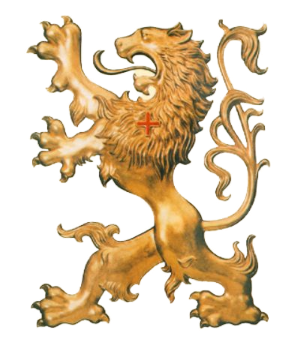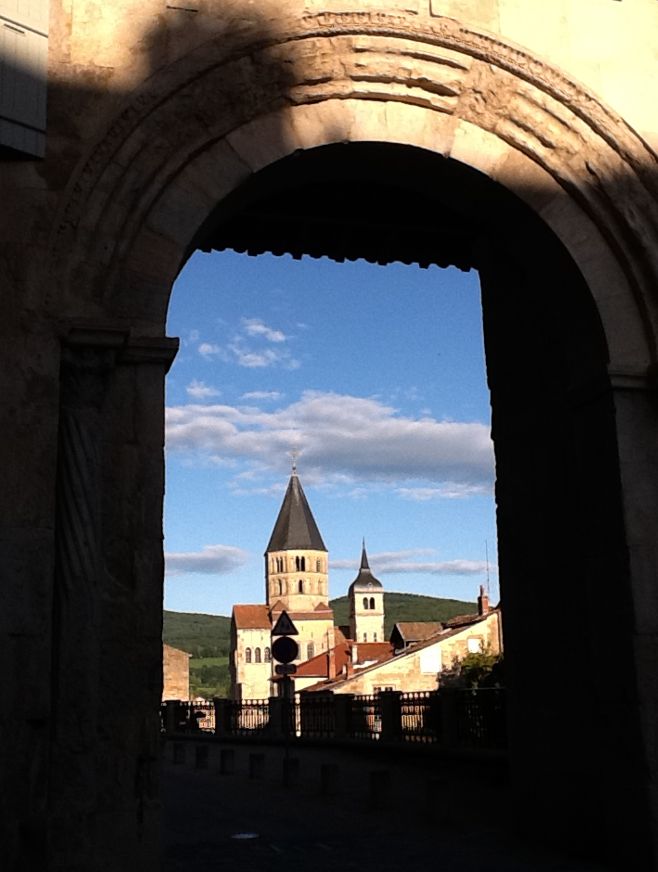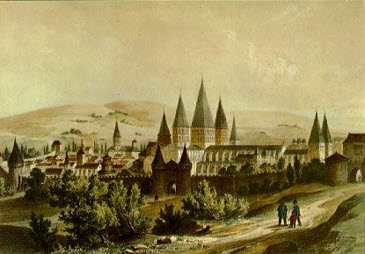|
Plinio Corrêa de Oliveira
The Spirit of Cluny and the Middle Ages We Need to Understand Cluny to Have the Spirit of What We Weep Over and Wait For
Saint of the Day, Thursday, February 26, 1970 |
|
|
Someone has asked me to say something about the subject that Professor Furquim dealt with in his series of lectures on Cluny. His question was, how can I define the spirit of Cluny in view of those lectures? What is the spirit of Cluny? I would say that the Middle Ages always appeared to me with a note that I would not call mysterious but challenging to express. When we consider each of the elements that constituted the medieval order of things, both on the temporal and above all the spiritual plane, we notice a curious thing. What I am going to say may seem banal, but I attach great importance to it. The Middle Ages is not only an era in the history of secular society. It is also an age of the Church. Not that the Church later stopped producing extraordinary fruits. In the Middle Ages, not only temporal society reached a remarkable fullness of Christianity, but the Church taken as a whole (and not as individual saints), also shone with a special light, a kind of glow and fullness that is difficult to qualify adequately. In the professor’s study, we notice study that Cluny was the matrix of the Middle Ages and the institution in which the Church generated this spirit. Cluny was, as it were, an organ of the Church which generated this fullness of spirit and passed it on to the Middle Ages. Therefore, the spirit of the Middle Ages and the spirit of Cluny are identical. As the professor rightly said, Cluny must be seen as the soul of the Middle Ages. I recall this analogy for us to understand that since this spirit has something impalpable, to characterize it we can have recourse to things that happened in the temporal and the spiritual orders, both of which that spirit invaded smoothly, strongly, and sovereignly. Now we have to try to characterize that order with examples from both. I would say that the spirit of Cluny—a facet of the Catholic spirit—is characterized first of all by having given a rare shine to the principle of unity in all things –- the idea that, because they form a whole - all existing orders of things must have a point of unity. Secondly, by existing, this unity is superior to all the elements that it encompasses. It is not like the center of a wheel to the wheel, but the tip of an arch to the arch. In other words, in every order, something superior somehow transcends the order and is the center that dominates and governs it. Thus, the idea of increasingly higher and broader authorities in their sphere reaches such a high point that it acquires sublimity hard to understand. That authority rules from on high with wisdom that you can understand only from those heights; with knowledge of all things that can only be had from that height; with the fullness of love for everything that you have only at that height; with full capacity to make itself loved by everyone and fullness of strength to subject everything from that height. The directing force that orients every small group within temporal society and spiritual society, then larger groups, and finally the two supreme groups in their respective orders—the Church and the Empire—that power always comes from on high and union always happens from top to bottom, from a tip like a pyramid’s. From that high point, it encompasses everything and makes [for smooth] relationships with all parties. Thus placed, the authority had a style of seeing, feeling, coordinating, and directing, which later broke down and societies lost. It did continue in the Church because She is eternal in her structure. But except for saints and elite souls, both the love of that and awareness of it disappeared from the Church. Accordingly, while the Church continues having a papacy, a hierarchy, and all her organization, the masses no longer realize how all that was worthy of love. The learning masses and the teaching masses no longer quite understand how that fullness has to be loved. They possess this treasure without seeing it. They are more or less like blind people who own beautiful art galleries and carefully maintain them while unable to see their beauty. We can see this situation, for example, in the concept of high authority. The higher authority is, the more it is enveloped in a sphere making it appear as one of coordination and benevolence, rather than command. Yet, all command comes from it and none could be conceived without it. For example, a king passing through a territory to rectify abuses or straighten things out. A king’s trip is successful when he finds abuses and has them rectified by his aides and lesser officers so he appears as a good, paternal, and beneficial monarch. However, his presence also instills fear and respect and puts everyone in order. Due to a lower [psychological] mechanism, his presence causes a vigorous ‘adjustment of the screws,’ which would never happen without it. Here you see a quintessence of authority at its highest point, which expresses well a style of authority and power people have lost sight of. You see this also in the popes. The popes of the Middle Ages condemned a lot, excommunicated a lot, and had a great impact. How? In the same way that kings ruled, that is to say, they intervened in great causes, made major moves, and left the administration of lesser things to lesser authorities. Except for great combats, in which the [pope as] king is also a warrior, papal power is kind and gentle, showing the pontiff’s paternity, receiving people and blessing crowds. Here you see a kind of “quintessentialization” of power that distills such richness and smoothness from the notion of power that one finds it difficult to reconcile with such force. If there was a time when popes and kings ruled the world, it was the Middle Ages. And if there was a time when they led the earth’s destiny, it was precisely the Middle Ages. At Cluny, the abbot was a synthesis and miniature of those two powers. Naturally, he was a spiritual lord but had a power with something of the temporal sphere over his monks, monasteries and lands. While he exercised it within the limits of his monasteries, they were huge, powerful monasteries of which we can hardly have an idea. Take, for example, the São Bento Monastery here in São Paulo. Passers-by find it very big. Yet it is a dwarf next to a medieval monastery placed in the countryside or near a city the size of Jundiaí or smaller. That is the proportion with things from the Middle Ages. Thus, a Benedictine abbot was a kind of pope and king in whom these powers merged. His governing style takes on something patriarchal - which the papacy and royalty never lost when popes and kings exercised it well. The more accentuated patriarchal aspect expressed that sense of unity and power. For an individual to be able to govern and move things ahead in this way, he needs to have a mentality and a kind of wisdom with his mind organized as an [Gothic] arch, tending to see everything objectively in its concrete, palpable and down to earth reality, without dreams or fantasies. On the other hand, he must irresistibly tend to see everything from this vantage point, looking to the highest considerations on the metaphysical and supernatural planes. Medievals conceived everything – from the shape of a bottle or tray to a child’s cry or a horse’s harness according to a certain spirit. Their mentality was ultimately dominated by and placed at the service of the faith by an intellect obedient to reason such that they were capable of everything. They could show every kind of strength and sweetness, all the calm and tranquility needed to reflect, and have unexpected and brilliant gestures. Depending on the circumstances, they could experience all joys, sorrows, and appropriate desolations. They were capable of etiquette and familiarity, eloquence and silence. In short, they were capable of showing all orderly [and harmonious] opposite extremes while at the same time never leaving a central point and a core stability. Theirs was not a horizontal center, but the pinnacle from which they saw, considered and ordered everything. It seems to me that, except for saints, humanity later lost this notion. It was erased at least among the vast majority of people. They even lost the ability to perceive or understand what it was. As you can see, even I find very indirect expressions to try to express this. However, we see Cluny in everything. Dr. Fernando gave a lot of aspects about Cluny. They showed such discipline and homogenization that it could seem almost socialistic. For example, everyone washed and dried their faces simultaneously and in the same way, and someone was there looking to see if they did it right. On the other hand, however, they developed strong and different personalities. Within the Cluniac silence and spaces, each person was like a tree on a prairie, finding all the room to lay down their branches without bumping into one another. They were not like confined and cramped trees in a forest, but like beautiful trees on a plain, which I like to see the most, where each tree gives everything it has, becomes massive with a magnificent crown, and seems the protector of the prairie. Every great Cluniac figure is like that. When you take each great Cluniac work, you see that it started from a point extremely different from what someone else did. For example, an illumination. Can you imagine the spirit of detail, patience, care, taste, observation, and smile it takes to make those medieval illuminations? Here we can see the same spirit applied to make a jewel-like letter to open a chapter; for example, an ‘O’ in the Advent Antiphons. The ‘O’ is a work of art that a monk makes while seated, without haste, anguish or worry about finishing. He puts in it everything his soul has conceived, and all the richness his meditations have given him. The same monk was formed alongside another who went to the Crusades, encouraged the Crusaders to take Jerusalem, participated in their flashes in Jerusalem, and so on. Another is a king’s counselor; another is the spiritual director of people who run a leper colony--when he does not join the colony himself. Everyone meets together and everything is very different but interchangeable so that, if the leper colony monk made illuminations, he would make them like that; if the maker of illuminations ran a leper colony, he would run it like that; if both went to war, they would do as each other; and if they were counselors to a king, they would act similarly. Let us say that someone is a colossus in the art of drying swamps and recovering land for the general use and the economy. He founded an abbey in a tremendous wilderness and implemented a new agricultural process and plantation. There, he converted a famous bandit and presided over the slaughter of a semi-diabolical beast found inside a cave. He has a unity of style that becomes like a top brand. Here you see a central style capable of all things, which reminds me of that passage from St. Paul about patience: it is capable of everything and does this, that and the other. What is patience there? It is the capacity to suffer and a resolve to suffer everything to attain the righteous supernatural ends one has in mind. We could say that the Cluniac spirit is this. It is like patience and includes patience as it is not limited to patience. It is capable of everything and remains entirely equal to itself. What is it? Someone would say: ‘making illuminations is part of the Cluniac spirit.’ I would say: Yes, just as the Cluniac spirit inspired feudalism or the Holy Roman Empire or a thousand things that did not exist at Cluny’s time, and to destroy a thousand things that came into existence after Cluny. One finds all that in the Cluniac spirit. Cluny is not like a religious order with a specific purpose, albeit very dignifiedly and righteously. As far as I can see, Cluny has no specific purpose; its purpose is to do everything, to inspire everything, to touch everything. So you can gauge the horror of Cluny’s fall. We do not know where the sin began, whether secular society sinned so much that God became more severe and rationed graces even for Cluny, or if Cluny began to sin and humanity wilted because of its sin. We see Cluny’s atrocious destruction. In the Ancien Régime, Cluny was an increasingly putrefying corpse, and the French Revolution destroyed it just as the temple of Jerusalem was destroyed. A few Cluny-related buildings remain, but they were not part of the monastery but a kind of suburb, and are in the last state of degradation. After having loved, protected, and placed Cluny at the center of the earth and the Church, God, deservedly displeased with that instrument, wisely cast it aside and handed it over to the shame of utter decay and the fury of all enemies. However, in one thing I still see Cluny’s greatness. Jerusalem was not overthrown by God’s enemies but by heathens. But, more or less like Byzantium, they no longer represented the true Church when razed. They were scoundrels taking down others scoundrels. The difference between heretics and schismatics and pagans is not that great. Cluny was overthrown by Church enemies out of hatred for the Church; Cluny’s ashes still bothered and had to be dispersed. Here we see the power of Cluny. The Revolution pulled all the stops with unequaled hatred to destroy that stone corpse that was Cluny. My impression is that Cluny could not continue because they were afraid that something from those ashes that once did so much harm to the revolutionary cause could resurrect. It reminds me of something by Louis Veuillot, who said he asked God that his ashes might cause discomfort to Church opponents even after his death. That is how far he wanted to take his fight. In the height of decay, Cluny’s ashes still bothered so much that they were scattered. Here you have a little idea of the spirit of Cluny. What benefit can we draw from studying this spirit? If we are medievals mourning the death of the Middle Ages and waiting for the Reign of Mary, we are a drop at the bottom of a valley between two mountains. For us who live at the bottom of the valley, nothing is better than to consider the mountain top. We need to understand well the spirit of Cluny to have the spirit of what we weep over and hope for. In the ultimate analysis, its majestic, sovereign, paternal, warlike, resigned, heroic, selfless, unpretentious, multifaceted and multifariously powerful spirit was the incomparable charm of the Middle Ages. I could not say more but think I have fulfilled your wish by saying what I said.
Cluny, before the French Revolution |
|



